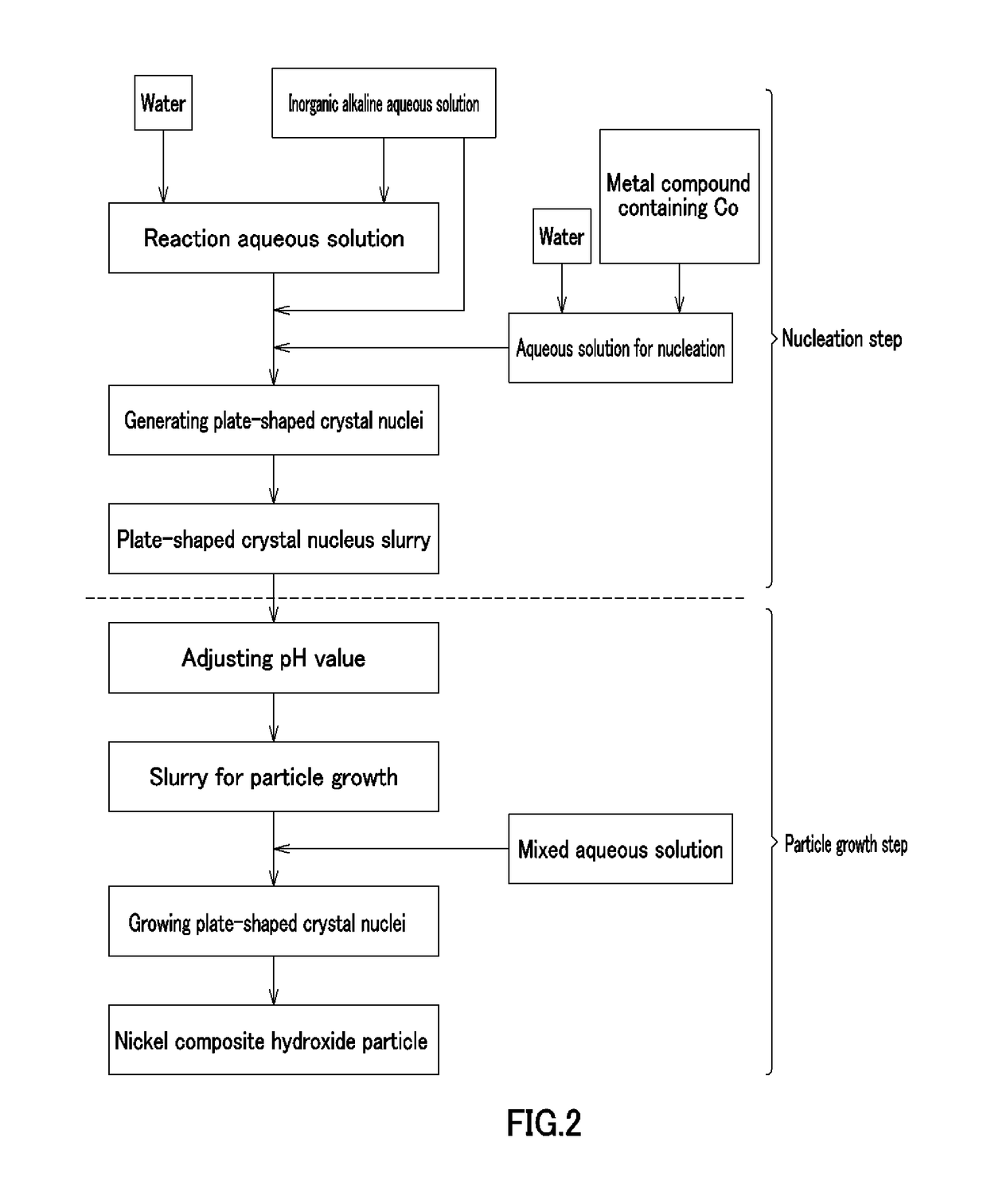Nickel composite hydroxide and process for producing same, positive electrode active material and process for producing same, and non-aqueous electrolyte secondary battery
a technology of composite hydroxide and positive electrode active material, which is applied in the direction ofnickel compounds, cell components, transportation and packaging, etc., can solve the problems of failure to disclose any battery capacity, adverse effects on output characteristics, and difficulty in the prior art to industrially acquire positive electrode active materials, etc., to achieve high electrode density, and high output characteristics and battery capacity
- Summary
- Abstract
- Description
- Claims
- Application Information
AI Technical Summary
Benefits of technology
Problems solved by technology
Method used
Image
Examples
example 1
[0255][Nucleation Step]
[0256]According to Example 1, cobalt (II) sulfate heptahydrate (Co molar concentration: 1.38 mol / L) and 900 mL of pure water were put in a crystallization reaction container of 5 L in volume equipped with four baffle plates, and warmed to 60° C. in a thermostatic tank and a warming jacket while stirring at a revolving speed of 1000 rpm with six inclined blade paddles, thereby providing an unreacted aqueous solution. A nitrogen gas was distributed in the reaction container, thereby providing a nitrogen atmosphere therein, and the oxygen concentration was 1.0% in the space in the reaction rank in this case. An aqueous solution of 6.25 mass % sodium hydroxide was supplied at 42 mL / min to increase the pH of the unreacted aqueous solution up to 13 on the basis of a liquid temperature of 25° C., and then stirred continuously for 30 minutes, thereby providing plate-shaped crystal nucleus-containing slurry.
[0257][Particle Growth Step]
[0258]According to Example 1, an a...
example 2
[0264]According to Example 2, a nickel composite hydroxide was obtained in the same way as in Example 1, except that the pH in the nucleation step was adjusted to 13.7 on the basis of a liquid temperature of 25° C. The secondary particles of the nickel composite hydroxide obtained were 9.6 μm in volume average particle size (Mv), and 10.7 in aspect ratio.
[0265]According to Example 2, a positive electrode active material was obtained and evaluated in the same way as in Example 1, except for the use of the nickel composite hydroxide obtained. The evaluation results are shown in Tables 1 and 2.
example 3
[0266]According to Example 3, a nickel composite hydroxide was obtained in the same way as in Example 1, except that the pH in the nucleation step was adjusted to 12.7 on the basis of a liquid temperature of 25° C. The secondary particles of the nickel composite hydroxide obtained were 11.8 μm in volume average particle size (Mv), and 5.5 in aspect ratio.
[0267]According to Example 3, a positive electrode active material was obtained and evaluated in the same way as in Example 1, except for the use of the nickel composite hydroxide obtained. The evaluation results are shown in Tables 1 and 2.
PUM
| Property | Measurement | Unit |
|---|---|---|
| volume average particle size | aaaaa | aaaaa |
| diameters | aaaaa | aaaaa |
| thickness | aaaaa | aaaaa |
Abstract
Description
Claims
Application Information
 Login to View More
Login to View More - R&D
- Intellectual Property
- Life Sciences
- Materials
- Tech Scout
- Unparalleled Data Quality
- Higher Quality Content
- 60% Fewer Hallucinations
Browse by: Latest US Patents, China's latest patents, Technical Efficacy Thesaurus, Application Domain, Technology Topic, Popular Technical Reports.
© 2025 PatSnap. All rights reserved.Legal|Privacy policy|Modern Slavery Act Transparency Statement|Sitemap|About US| Contact US: help@patsnap.com



